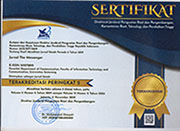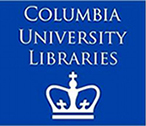Social Presence of Ruangguru in Social Media during Covid-19 Pandemic
Abstract
Covid-19 Pandemic gives many social changes in society specially in communications study. One important policy made during Covid-19 is related to students who are required to study at home. Ruangguru is top of mind in digital based learning company, especially during this pandemic. Covid-19 and this policy made Ruangguru as Indonesia online learning company with the most followers, to adapt in giving online communication message, especially in @ruangguru (Instagram). This research aims to see the social presence of Ruangguru in social media (Instagram) during Covid-19 Pandemic through three dimensions of social presence, which are: social context, online communication, and interactivity. On previous research, it was mentioned that social presence relates to brand engagement. Brand's social presence in social media is important to be researched due to more brand using social media as primary communication tool to gain brand engagement. Method used in this research is case study with qualitative approach. Through Ruangguru's post on Instagram, researcher observes using three dimensions of social presence. The result of this research depicts Ruangguru as showing good social presence based on three dimensions of social presence during Covid-19 Pandemic in social media Instagram.
Keywords
Full Text:
PDFReferences
Baxter, L. A., & Babbie, E. (2004). The Basics of Communication Research. Belmont: Holly J. Allen.
Caspi, A., & Blau, I. (2008). Social presence in online discussion groups: Testing three conceptions and their relations to perceived learning. Social Psychology of Education: An International Journal, 11(3), 323 346. https://doi.org/https://doi.org/10.1007/s11218-008-9054-2
Chaffey, D., & Smith, P. (2017). Digital Marketing Excellence: Planning, Optimizing and Integrating Online Marketing (Fifth). New York: Routledge.
Chang, C.-M., & Hsu, M.-H. (2016). Understanding the determinants of users subjective wellbeing in social networking sites: an integration of social capital theory and social presence theory. Behaviour & Information Technology 35. Journal of Brand Management, 10(9), 33 58.
Cowan, L. (2006). Understanding Social Context : Literature Review. https://doi.org/10.13140/RG.2.1.3035.4084
Cui, G., Lockee, B., & Meng, C. (2013). Building modern online social presence: A review of social presence theory and its instructional design implications for future trends. Education and Information Technologies, 18(4), 661 685. https://doi.org/10.1007/s10639-012-9192-1
David, M., & Sutton, C. D. (2004). Social Research: The Basics. London: SAGE.
Davis, R., Piven, I., & Breazeale, M. (2014). Conceptualizing the brand in social media community: The five sources model. Journal of Retailing and Consumer Services, 21(4), 468 481. https://doi.org/10.1016/j.jretconser.2014.03.006
De Vries, L., Gensler, S., & Leeflang, P. S. H. (2012). Popularity of Brand Posts on Brand Fan Pages: An Investigation of the Effects of Social Media Marketing. Journal of Interactive Marketing, 26(2), 83 91. https://doi.org/10.1016/j.intmar.2012.01.003
Duffy, A. (2015). The road more travelled: How user-generated content can lead to homogenized travel journalism. Continuum, 29(6), 821 832. https://doi.org/10.1080/10304312.2015.1073686
Eriyanto. (2011). Analisis isi: Pengantar Metodologi untuk Penelitian Ilmu Komunikasi dan Ilmu-ilmu Sosial lainya. Indonesia: Prenada Media Group.
Gironda, J. T., & Korgaonkar, P. K. (2014). Understanding consumers social networking site usage. Journal of Marketing Management, 30(5 6), 571 605. https://doi.org/10.1080/0267257X.2013.851106
Hasanuddin, Pramudibyanto, H., & Hermawati, Y. (2012). Kehadiran Sosial Dosen UT dalam CMC (Computer Mediated Communication) melalui Aktivitas Tutorial Online (Pengembangan Model Panduan Komunikasi bagi Tutor Tutorial Online UT). Lembaga Penelitian dan Pengabdian Kepada Masyarakat Universitas Terbuka.
Helal, G., Ozuem, W., & Lancaster, G. (2018). Social media brand perceptions of millennials. International Journal of Retail and Distribution Management, 46(10), 977 998. https://doi.org/10.1108/IJRDM-03-2018-0066
Joo, T. M., & Teng, C. E. (2016). use of Social Media in PR: A Change of Trend. World Academy of Science, Engineering and Technology International Journal of Humanities and Social Sciences, 10(4), 1279 1288.
Kartosapoetro, I. S. (2019). RuangGuru dan Perubahan Pendidikan di Indonesia. Retrieved July 7, 2020, from Detik.com website: https://news.detik.com/kolom/d-4406697/ruangguru-dan-perubahan-pendidikan-di-indonesia
Khan, A. R. (2009). Digital Signage System (Royal Institute of Technology (KTH)). Retrieved from http://kth.diva-portal.org/smash/get/diva2:510432/FULLTEXT01.pdf
Kirk, S. A., & Sigrid, K. (2012). Computer-Mediated Communication Across Cultures: International Interactions in Online Environments. IGI Global.
Kotler, P., Kartajaya, H., & Setiawan, I. (2017). Marketing 4.0 Moving from Traditional to Digital. New Jersey: John Wiley & Sons, Inc.
Kurniawan, F. (2020). Digita Dilemma: Problem Kontemporer Adopsi Media Digital di Indonesia. Depok: Rajawali Pers.
Llopis, G. (2014). Consumers Are No Longger Brand Loyal. Retrieved November 3, 2019, from Forbes.com website: https://www.forbes.com/sites/glennllopis/2014/12/10/consumers-are-no-longer-brand-loyal/#62d665892ae0
Lovejoy, K., & Saxton, G. D. (2012). Information, Community, and Action: How Nonprofit Organizations Use Social Media. Journal of Computer-Mediated Communication, 17(3), 337 353. https://doi.org/10.1111/j.1083-6101.2012.01576.x
Lowenthal, P. R. (2009). The Evolution and Influence of Social Presence Theory on Online Learning. 124 139. https://doi.org/10.4018/9781605669847.ch010
Man, N. I., Abdullah, A. P. D. Z., Tamam, E., & Hasan, N. A. (2019). A Communications Strategy of the Malaysian Research Universities to add Value. Jurnal The Messenger, 11(1), 56. https://doi.org/10.26623/themessenger.v11i1.1211
Masyrafina, I. (2020). Karantina di Rumah, Pengguna Aplikasi Belajar Naik Drastis. Retrieved from Republika website: https://republika.co.id/berita/q81lwm380/karantina-di-rumah-pengguna-aplikasi-belajar-naik-drastis
Moleong, L. J. (2017). Metodologi Penelitian Kualitatif (36th ed.). Bandung: PT. Remaja Rosdakarya Offset.
Moro, S., & Rita, P. (2018). Brand strategies in social media in hospitality and tourism. International Journal of Contemporary Hospitality Management, 30(1), 343 364. https://doi.org/10.1108/IJCHM-07-2016-0340
Nambisan, P., & Watt, J. H. (2011). Managing customer experiences in online product communities. Journal of Business Research, 64(8), 889 895. https://doi.org/10.1016/j.jbusres.2010.09.006
Osei-Frimpong, K., & McLean, G. (2018). Examining online social brand engagement: A social presence theory perspective. Technological Forecasting and Social Change, 128(September 2017), 10 21. https://doi.org/10.1016/j.techfore.2017.10.010
Pranata, E. W., Latif, M. C., & Fanani, F. (2019). Symbolic Interaction of The Deaf Students in Public School. Jurnal The Messenger, 11(1), 1. https://doi.org/10.26623/themessenger.v11i1.876
Saxton, G. D., & Waters, R. D. (2014). What do Stakeholders Like on Facebook? Examining Public Reactions to Nonprofit Organizations Informational, Promotional, and Community-Building Messages. Journal of Public Relations Research, 26(3), 280 299. https://doi.org/10.1080/1062726X.2014.908721
Shimp, T. A., & Andrews, J. C. (2013). Advertising, Promotion, and other aspects of Integrated Marketing Communications. In Integrated Marketing communications (9 ed). Retrieved from https://scholarsbank.uoregon.edu/xmlui/bitstream/handle/1794/19082/Thesis Final-Bulka.pdf?sequence=1
Skinner, C. (2019). Manusia Digital (Terjemahan). Jakarta: PT Elex Media Komputindo.
Slack, F., & Rowley, J. (2001). Observation: Perspectives on research methodologies for leisure managers. Management Research News, 24(1 2), 35 42. https://doi.org/10.1108/01409170110782496
Straubhaar, J., LaRose, R., & Davenport, L. (2012). Media Now: Understanding Media, Culture and Technology (7th ed.). Wadsworth.
Tu, C. H. (2002). The impacts of text-based CMC on online social presence. Journal of Interactive Online Learning, 1(2), 1 24.
DOI: http://dx.doi.org/10.26623/themessenger.v12i2.2276
Refbacks
- There are currently no refbacks.
Copyright (c) 2020 Jurnal The Messenger
View My Stats [Jurnal The Messenger] is an International Scientific Journal, Published by the Department of Communication, Faculty of Information Technology and Communication, Universitas Semarang (Central Java, Indonesia). It is licensed under a Creative Commons Attribution 4.0 International License.



_11.jpg)




_BARCODE.jpg)
_BARCODE1.jpg)


5.png)










2.png)





